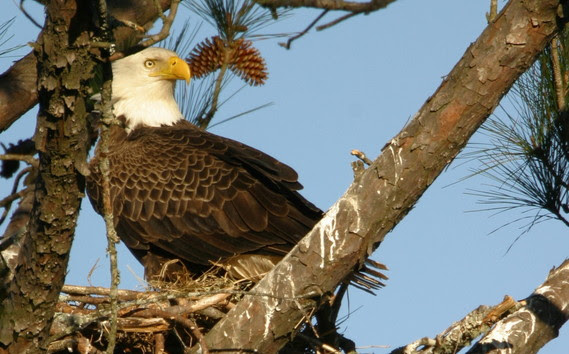
Georgia’s first statewide survey of bald eagle nests in five years showed the national bird nesting in record numbers, according to the Georgia Department of Natural Resources.
Survey flights this winter and spring to find and monitor nesting bald eagles counted 229 nest territories. That tops the previous high of 218 set in 2017, survey leader Dr. Bob Sargent said. Except for COVID-related changes last year, the agency changed its surveys after 2017 to check most regions every other year.
This year’s nests fledged 227 eagles, or almost 1.6 per nest, slightly more than the 2017 average. While most nests had one to two eaglets, a bald eagle couple near Columbus raised three young to flight.
Not all of the news was good. As DNR announced in April, the viral disease called highly pathogenic avian influenza – or bird flu – hammered bald eagles on the coast. In the region home to about a third of Georgia’s eagle nests, nest success dropped about 30 percent this year, with fewer than half fledging at least one young.
But Sargent, a program manager with DNR’s Wildlife Conservation Section, said the big picture is encouraging.
“It’s important to remember that the bald eagle population has exhibited a remarkable rebound in the last 50 years. And although the coastal nests took a hit from the virus, the more than 150 nests elsewhere in the state experienced normal productivity.”
DNR monitors eagle nesting by helicopter twice a year, splitting the state into five areas for surveys. Flights in January and February mark nests in use. Follow-ups in March and April are mainly to gauge how the nests fared.
Georgia appears to have maintained more than 200 occupied nest territories annually since 2015, according to Sargent. Although findings this year suggest the state’s nesting population of bald eagles continues to increase, the growth rate has slowed substantially compared to 2007-2015 when nest totals surged from 114 to 210.
Minus influenza-affected totals in coastal counties, nest success this year ranged from just below average in southwest Georgia (65 percent) to average in the north/northwest (77 percent) and significantly above average – 90 percent – in the east/northeast region. Overall, the numbers are in line with previous years. Sargent said local factors, such as unusually heavy rainfall before or early in the nesting season, can affect regional results.
“It’s tempting to look at the 65 percent success rate for southwest Georgia, which is about 10 percent below the norm, and wonder if there was something wrong. But fluctuations of that magnitude are not unusual, and the good news is that we found 21 new nests in that area of the state. That’s especially remarkable when I think back to the more than dozen nest trees toppled in that area by Hurricane Matthew in October 2018.”
On the coast, the 73 nest territories recorded was typical, but only 47 percent fledged at least one young. Nests that succeeded fledged 1.5 young each, which is average. However, the 50 eaglets fledged fell far shy of the total the coast normally produces, according to Sargent. The survey revealed more failed nests than expected. Some had dead eaglets. Others were missing young that usually would not have left the nest by that time.
The carcasses of eight ducks and three bald eagles collected on the coast in February and March tested positive for highly pathogenic avian influenza, or HPAI. Sargent said it’s possible some eagles were infected by preying or scavenging on dead or sick waterbirds. Ducks often gather in large rafts in coastal waters during winter.
In the months since the waterfowl that winter in Georgia migrated to their breeding areas in the northern U.S. and Canada, no eagles found in the state have tested positive for HPAI, Sargent said.
“The results of the coastal survey were worrisome and discouraging. We are keeping a close eye on reports of HPAI in eagles, vultures and waterfowl in the northern U.S. and keeping our fingers crossed that a resurgence of the virus does not occur when ducks, vultures and eagles that winter in the South return to the state this fall.”
The bald eagle has rebounded in Georgia and across the species’ range. Factors feeding that recovery include a U.S. ban on DDT use in 1972, habitat improvements after enactment of the federal Clean Water and Clean Air acts, protection through the Endangered Species Act, increased public awareness, restoration of local populations through release programs, and forest regrowth.
Following a steep decline in the eagle population in Georgia, the state went from no known successful nests throughout most of the 1970s to one in 1981, 47 by the turn of the century and more than 200 occupied nest territories today, about 75 percent of which are usually successful.
The public is encouraged to report eagle nests via https://georgiawildlife.com/bald-eagle, (478) 994-1438) or bob.sargent@dnr.ga.gov. Such reports typically lead to the discovery of 10-15 new nests a year. (Tip: Osprey nests are sometimes confused with eagles. Learn more at https://georgiawildlife.com/bald-eagle.)
DNR works with landowners to help protect bald eagle nests on private property. Although de-listed from the Endangered Species Act in 2007, eagles are protected by the Bald and Golden Eagle Protection Act, the Migratory Bird Treaty Act, and state law. In Georgia, the species has a state classification of threatened.
The surveys of these iconic birds are part of the DNR Wildlife Conservation Section’s mission to conserve nongame wildlife – native animals not legally hunted or fished for – and native plants and natural habitats.
The conservation of bald eagles is supported in part by Georgians who buy an eagle or monarch license plate or renew these or the older hummingbird designs. The tags cost only $25 more than a standard license plate and $19 of each purchase and $20 of each annual renewal goes to help conserve bald eagles and hundreds of other Georgia plant and animal species listed as species of conservation concern.
Learn more at https://georgiawildlife.com/bald-eagle. See how that support is put to work www.georgiawildlife.com/conservation/AnnualReport.
Nest Survey Stats
Occupied bald eagle nest territories in Georgia: 229 (DNR monitored 227)
- Successful nests: 146
- Young fledged: 227 (1.56/nest)
- New nests (not surveyed before): 37
- By state region – occupied nests/successful nests/young fledged/new nests:
- Coast: 73/34/50/9
- Southwest: 96/62/95/21
- East/northeast: 30/27/41/4
- Southeast: 6/6/9/1
- Previous state record (2017): 218 occupied nest territories, 142 successful, 218 young fledged
How This Works
DNR began monitoring bald eagle nesting in Georgia in the 1980s. The Wildlife Conservation Section now checks nests by helicopter in January-February and again in March-April. This year was the first time the entire state has been surveyed since 2017, when the effort was scaled back. From 2018-2020, about 50-70 percent of Georgia was surveyed annually. However, because of COVID issues only the coastal counties were flown in 2021.
Since 2017, the survey has been split into five regions: the six coastal counties, southwest Georgia, east/northeast (most of the area between Interstates 16 and 85 east of Atlanta and Macon), north/northwest and southeast (bounded by interstates 75 and 16 and west of the coastal counties). Coastal counties, where about a third of nest territories are found, are surveyed annually. Other sections are checked in an every-other-year rotation. The southeast area has the fewest nests and is mostly monitored by volunteers on foot.
Flights involve two rounds. The first, started between January’s second and fourth week, focuses on finding all active nests. An active nest that has eggs, eaglets (rare in Georgia in January), an adult eagle in an incubating posture or evidence eagles have been prepping it for use. The second round, from mid-March to early April, gauges the reproductive outcome of those nests and checks reports of new ones. By late winter, most nests have eaglets 4-14 weeks old or they are empty because the nest failed or, in a few cases, the eaglets fledged.
Nest cycles: DNR survey leader Dr. Bob Sargent said there is a marked latitudinal gradient for the timing of the nest cycle. Eagles on the coast nest and fledge young earlier than those in middle Georgia and much earlier than those nesting around mountain reservoirs. As with all birds, the causes of nests failing vary. They include severe weather, the death of one or both parents, insufficient food available to rear the young and predation of eggs or the young by raccoons, great horned owls and other wildlife.
Aviation aid: By the end of this year’s surveys, Sargent and DNR pilots Capt. Jay Bridwell and Lt. Jamie Allen had peeked into nearly 300 nests from Walker to Camden County. Sargent calls the pilots “ornithologists in training” and said their role in the surveys goes beyond flying. “They often find the nests before I do, they are as fascinated by the big birds as I am and they are especially conscientious about keeping a safe distance from the nests – for the eagles’ sake – while giving me the best possible look at the contents.”
Ga DNR


Bulloch Public Safety
7/15/2025 Booking Report for Bulloch County

Chattooga Local Government
K-9 Georgia Dies in Hot Patrol Car; Dade County Launches Investigation

Chattooga Local News
Obituary: Mr. Chris “Hollywood” Ledbetter

Bulloch Public Safety
06/23/2025 Booking Report for Bulloch County

Bulloch Public Safety
06/30/2025 Booking Report for Bulloch County

Bulloch Public Safety
7/14/2025 Booking Report for Bulloch County

Bulloch Public Safety
06/16/2025 Booking Report for Bulloch County

Bulloch Public Safety
7/11/2025 Booking Report for Bulloch County






